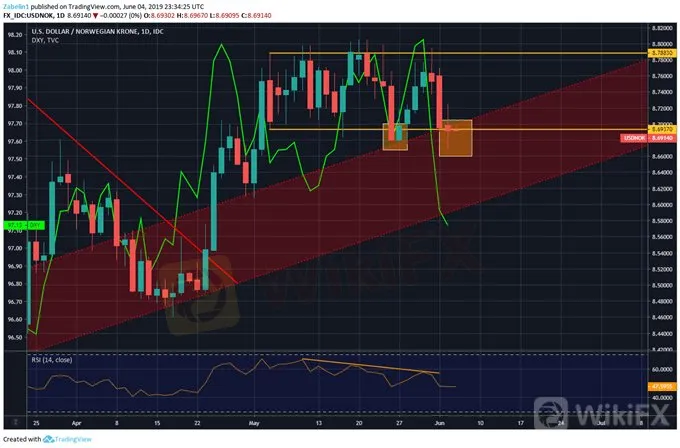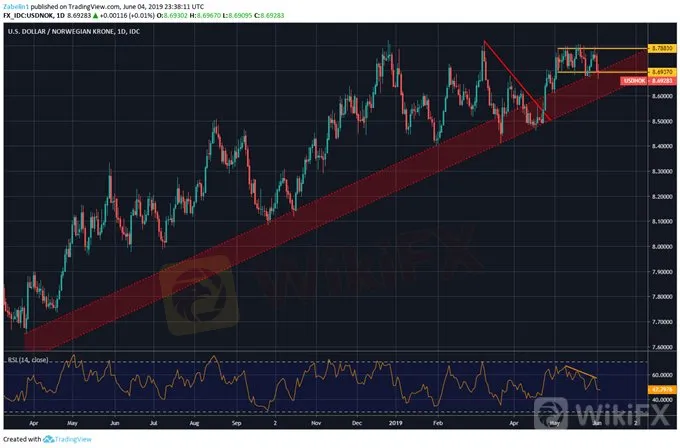简体中文
繁體中文
English
Pусский
日本語
ภาษาไทย
Tiếng Việt
Bahasa Indonesia
Español
हिन्दी
Filippiiniläinen
Français
Deutsch
Português
Türkçe
한국어
العربية
USDNOK Breaks Critical Support - USDSEK Retreats at Alarming Rate
Abstract:USDNOK and USDSEK are both experiencing retreats at an alarming rate, potentially opening the door to a short-term break in critical support areas.
NORDIC FX, NOK, SEK WEEKLY OUTLOOK
USDNOK, USDSEK retreating at alarming rates
Greenback weakness fueling fall – more ahead?
Fed rate expectations fueling recent USD selloff
See our free guide to learn how to use economic news in your trading strategy!
NORWEGIAN KRONE TECHNICAL ANALYSIS
After temporarily breaking below support, USDNOK recovered, though the respite was short lived after US Dollar weakness fueled by rising Fed rate cut expectations sent the pair lower. USDNOK is now trading in the upward-sloping support range (red parallel channel) and below the lower lip of the 8.6937-8.7883 range (yellow lines).
USDNOK Tests Key Support Levels

While it is largely expected that rising support will hold, a short-term retreat for the pair is not out of the question. In April, the pair came dangerously close to breaking below the 15-month support, only narrowly avoiding breaking below it. While the dominant uptrend will likely continue, a short-term retreat may be in the cards. Long traders may experience some growing pains as the pair continue to mature throughout 2019.
USDNOK – Daily Chart

SWEDISH KRONA TECHNICAL ANALYSIS
After trading consistently at a 17-year high, USDSEK has been on a downward decline and has shaved off over two percent. The culprit appears to be prevailing weakness in the US Dollar as market participants price in a higher-than-expected chance that the Fed will cut rates. Prior to the rapid descent, the pair stalled in the 9.5323-9.5767 (red dotted lines) range before throwing in the towel and dropping to 9.43.
USDSEK – Daily Chart

It is unlikely that USDSEK will reach as low as 9.3110 – that psychological floor will not likely be tested again this year. Assuming the fundamental outlook persists – or worsens – a premium will be put on liquidity over risk and that will likely cause USDSEK to continue along its broad upward-trajectory. The current setback will not likely hold, and in my view is nothing more than a temporary lull in the USDs appeal.
Since January 2018, USDSEK has experienced numerous setbacks before it recovered and resumed its upward trajectory. The temporary retreat for the pair may be a repeat of this. Traders will likely show greater worry if USDSEK tests or comes close to the 18-month rising support (blue parallel channel).
USDSEK Upward Trajectory Remains Strong

Disclaimer:
The views in this article only represent the author's personal views, and do not constitute investment advice on this platform. This platform does not guarantee the accuracy, completeness and timeliness of the information in the article, and will not be liable for any loss caused by the use of or reliance on the information in the article.
Read more

Europe Analysis: EUR/USD, GBP/USD, EUR/GBP
EUR/USD is mixed to bearish, influenced by resistance levels and upcoming data. GBP/USD is bullish with the pound at four-month highs on positive UK data and hawkish BoE comments. EUR/GBP remains volatile, reflecting diverging economic conditions in the Eurozone and the UK.

Europe Analysis: EUR/USD, GBP/USD, EUR/GBP
European trading is subdued due to the U.S. holiday, with the euro benefiting from weak U.S. data. The pound rises ahead of the UK election, supported by market sentiment. ECB President Christine Lagarde's comments on interest rates support the euro. Overall, mixed sentiment prevails with cautious trading expected. Key economic events include Eurozone retail sales, Germany's industrial production, and UK services PMI.

Rate Rumble: RBNZ, BoC, and ECB Take Centre Stage
The New Zealand central bank maintain its benchmark interest rate at 5.50% as expected during its previous meeting. While there was no surprise of the central bank paused rates, the less hawkish tone was a surprise as 23% of the market surveyed by Reuters predicted an interest rate hike. In February, the rate of consumer price growth in the United States picked up pace with the reading came in at 3.2%, surpassing expectations of 3.1% for underlying inflation.

Markets Q4 Outlook: Dow Jones, US Dollar, Gold, Fed, Euro, ECB, Oil, Volatility Returns?
As investors head into the fourth quarter, the VIX Volatility Index - often referred to as the market‘s ’fear gauge - is in an uptrend. In September, US benchmark stock indices saw some of the worst monthly performance since March 2020. In fact, the S&P 500 and Nasdaq 100 finished the third quarter little changed. More importantly, they trimmed most of their gains. The Dow Jones declined.
WikiFX Broker
Latest News
How Crypto Trading Transforms FX and CFD Brokerage Industry
FCA Warns Against 10 Unlicensed or Clone Firms
CySEC Warns Against 14 Unlicensed Investment Websites
Top Currency Pairs to Watch for Profit This Week - March 31, 2025
Will natural disasters have an impact on the forex market?
Philippines Deports 29 Indonesians Linked to Online Scam Syndicate in Manila
Exposing the Top 5 Scam Brokers of March 2025: A Closer Look by WikiFX
Gold Prices Climb Again – Have Investors Seized the Opportunity?
Webull Launches SMSF Investment Platform with Zero Fees
Australian Regulator Warns of Money Laundering and Fraud Risks in Crypto ATMs
Currency Calculator







